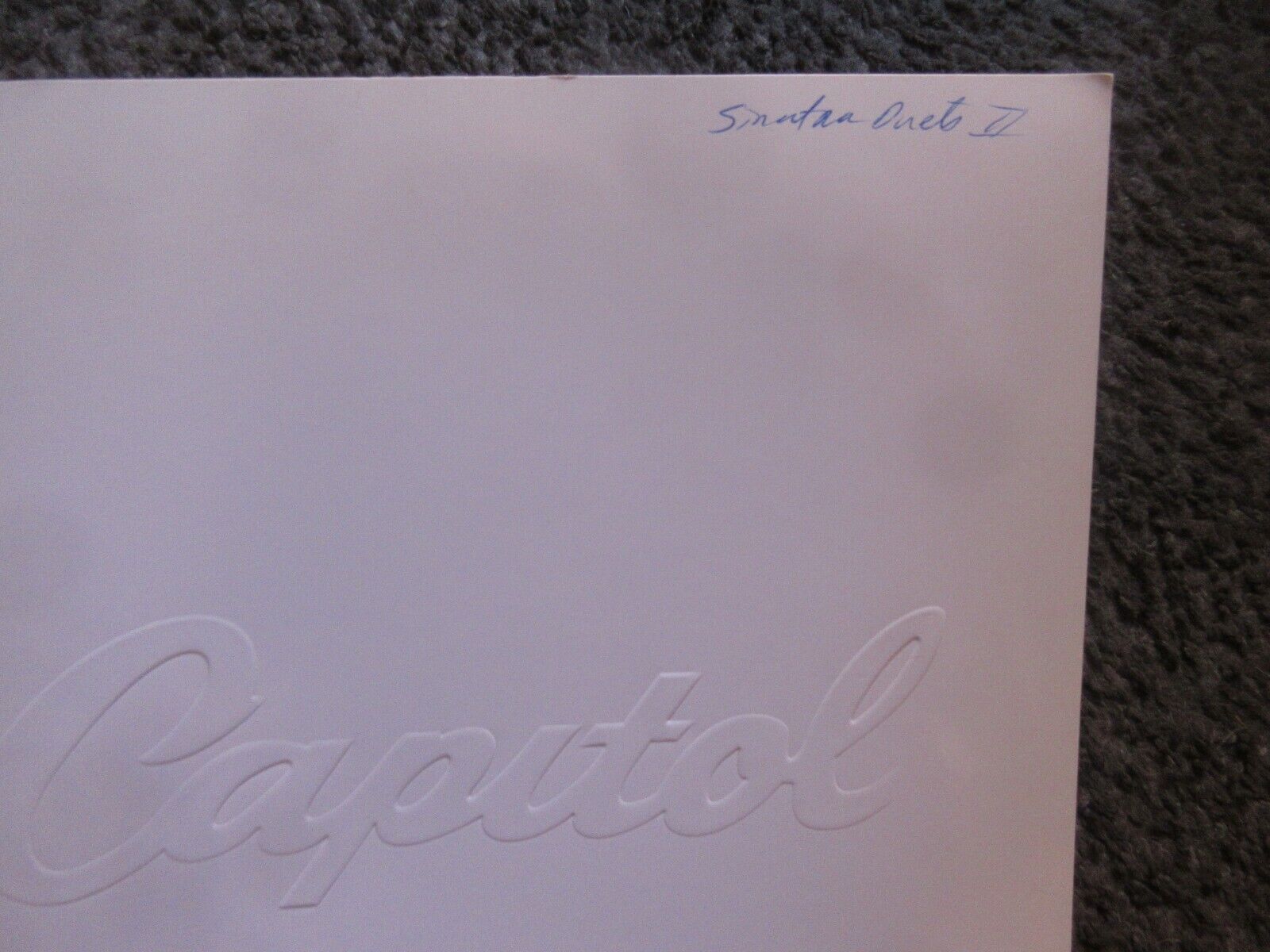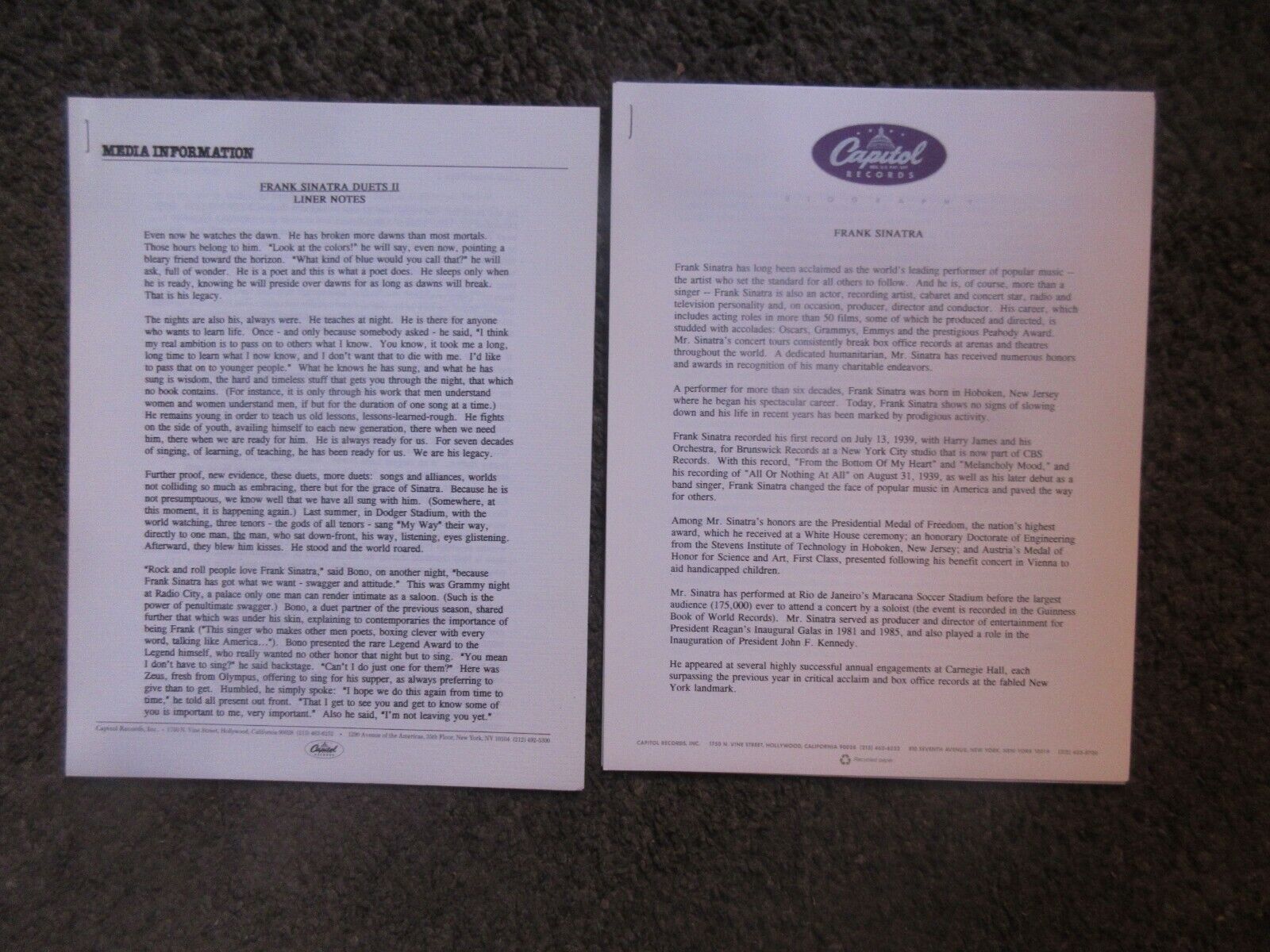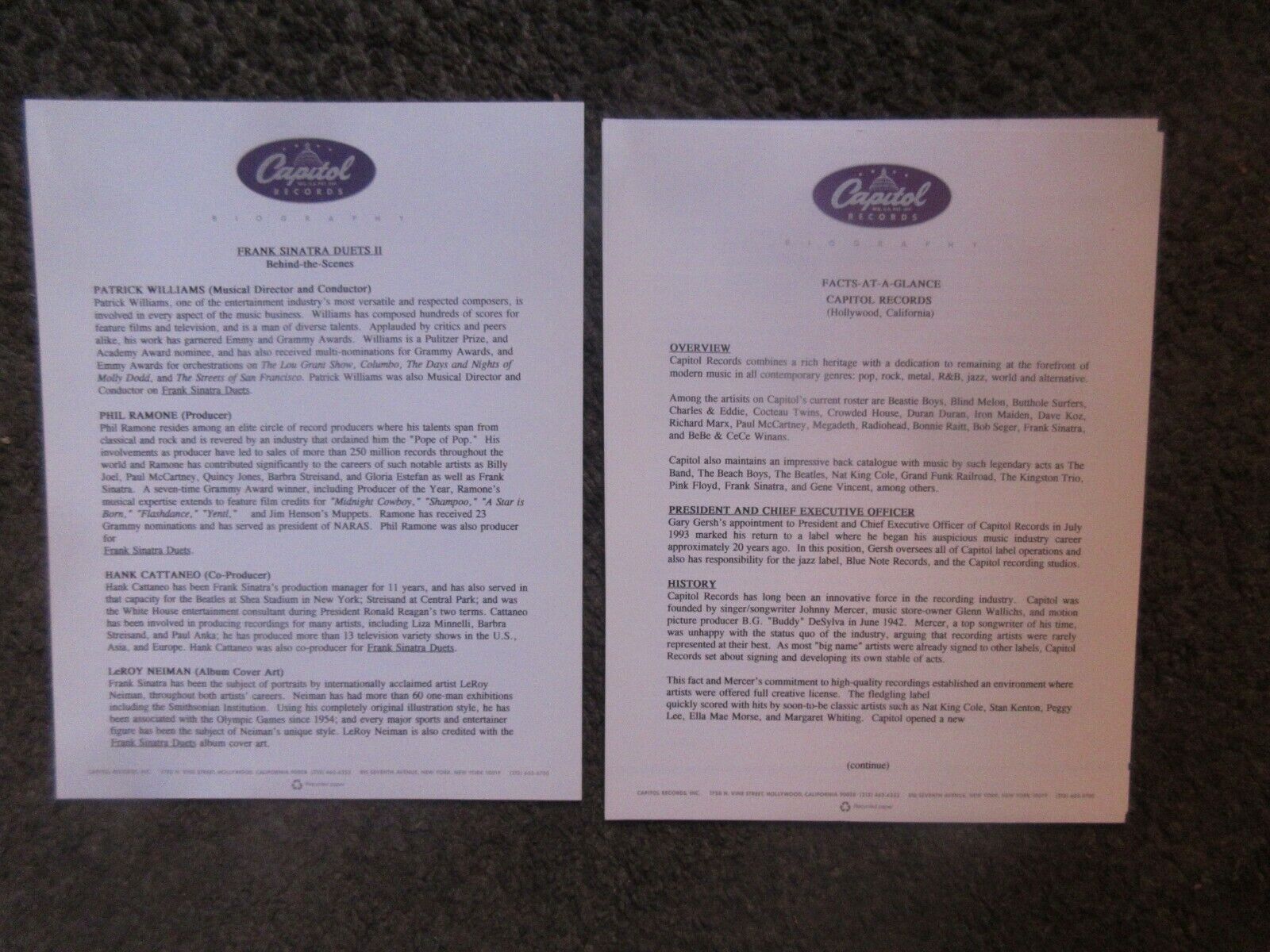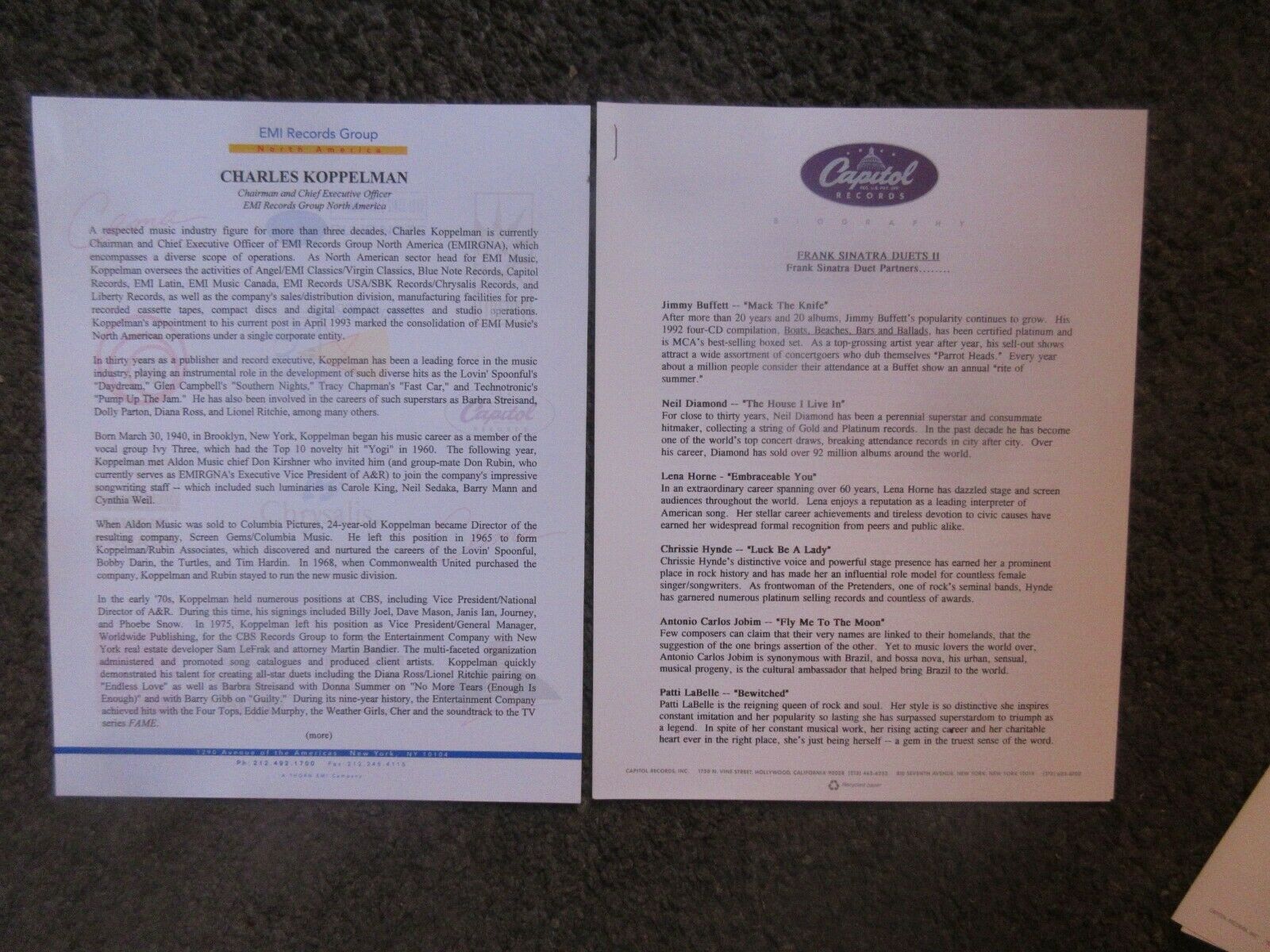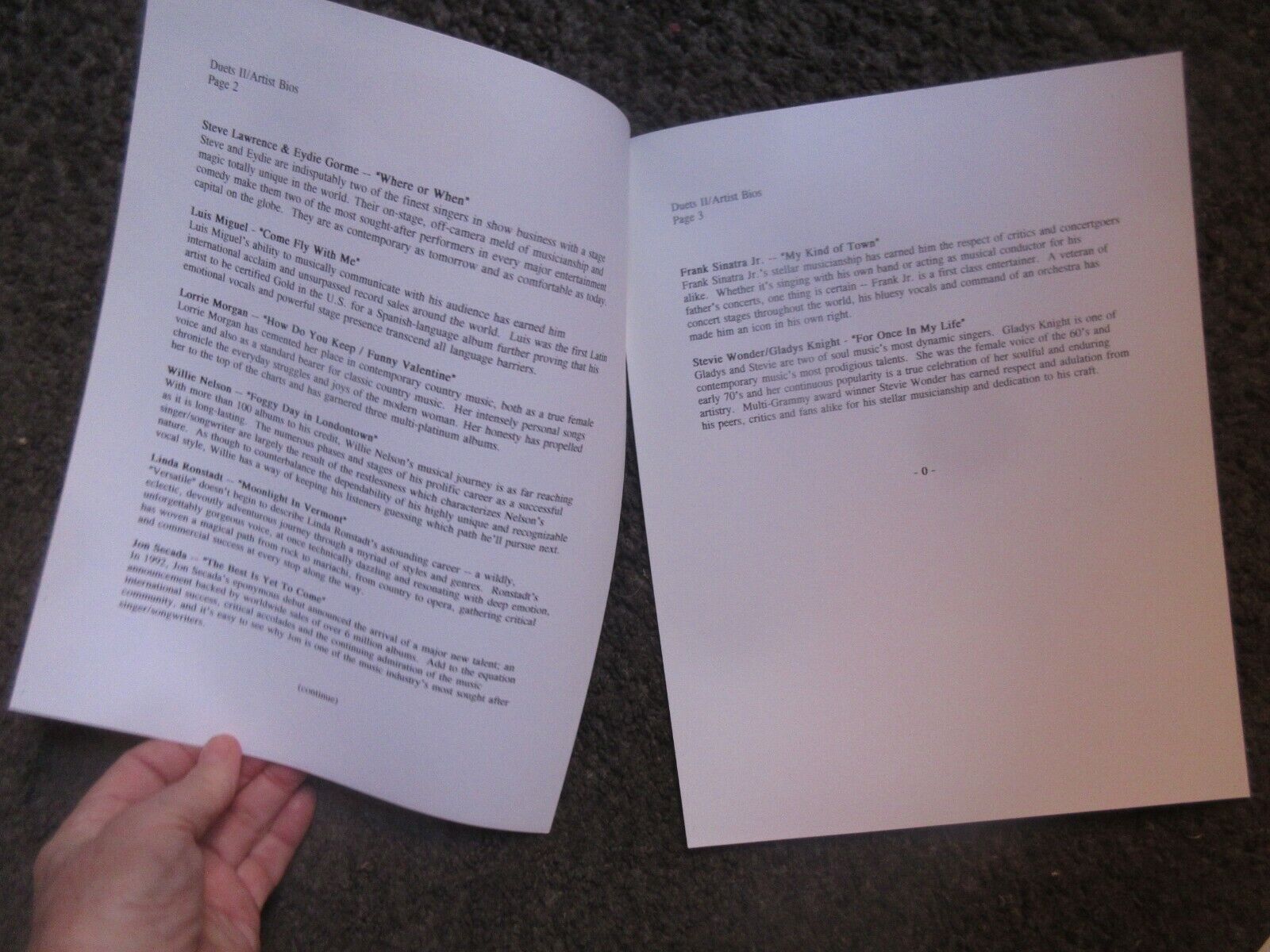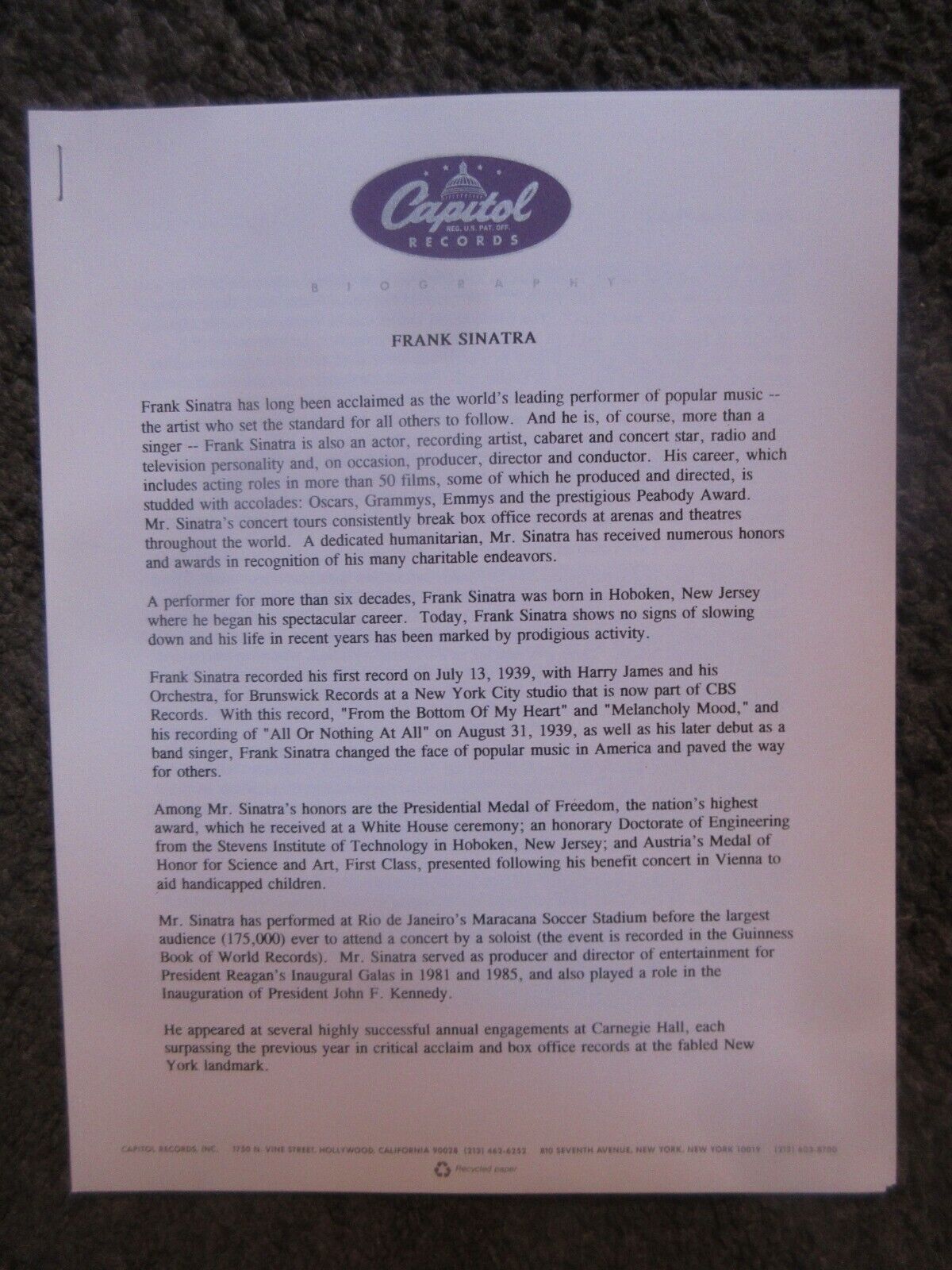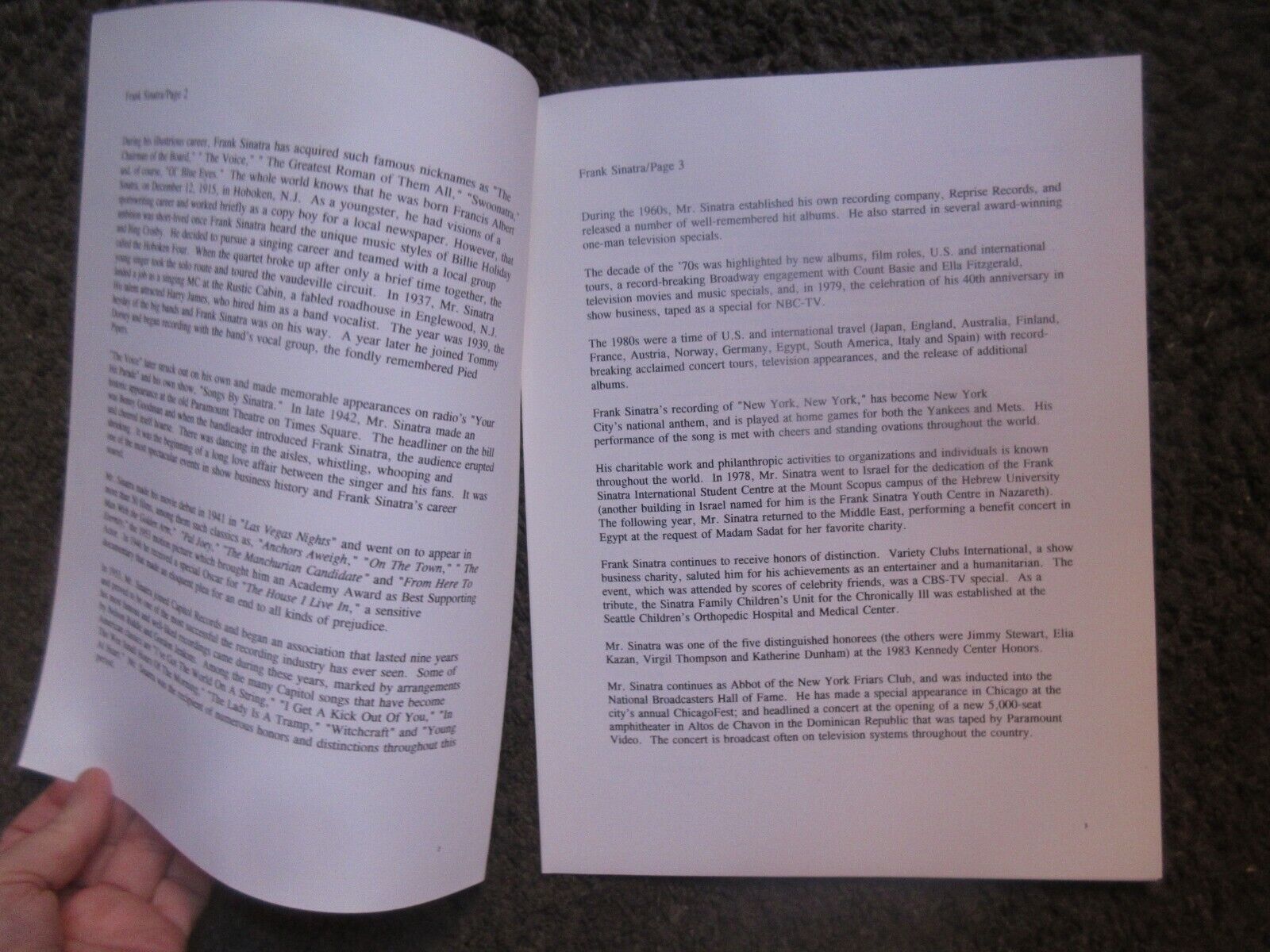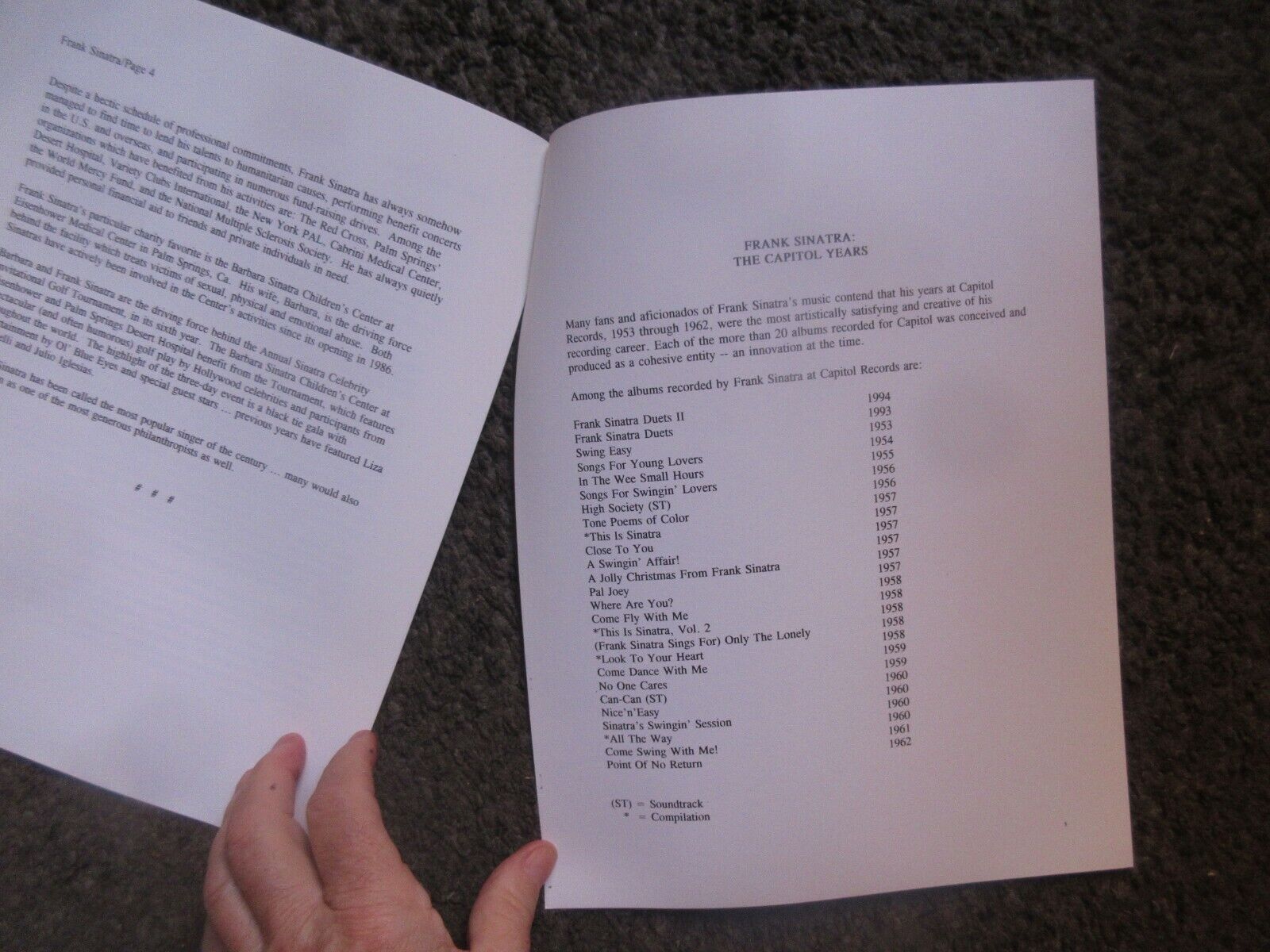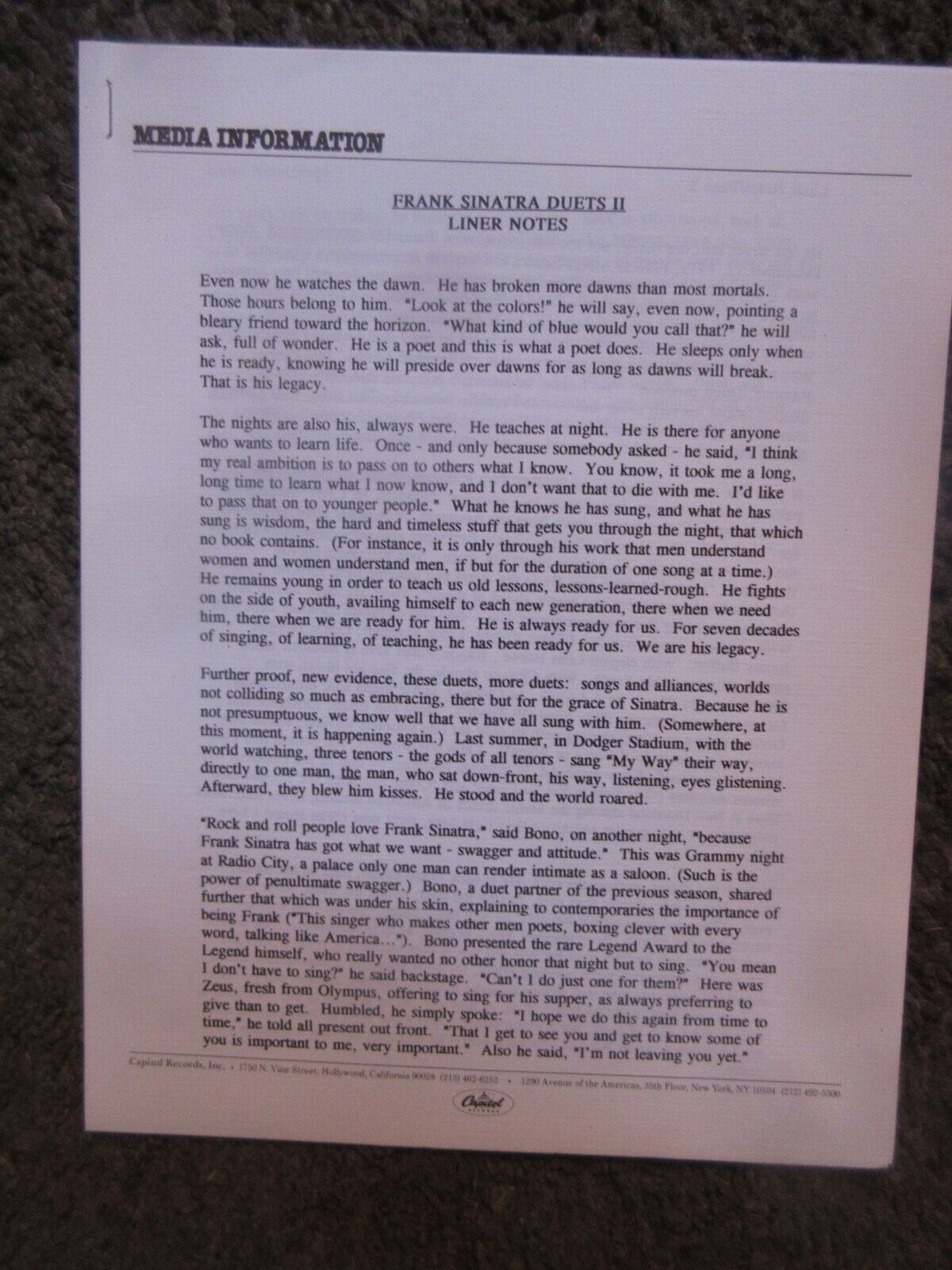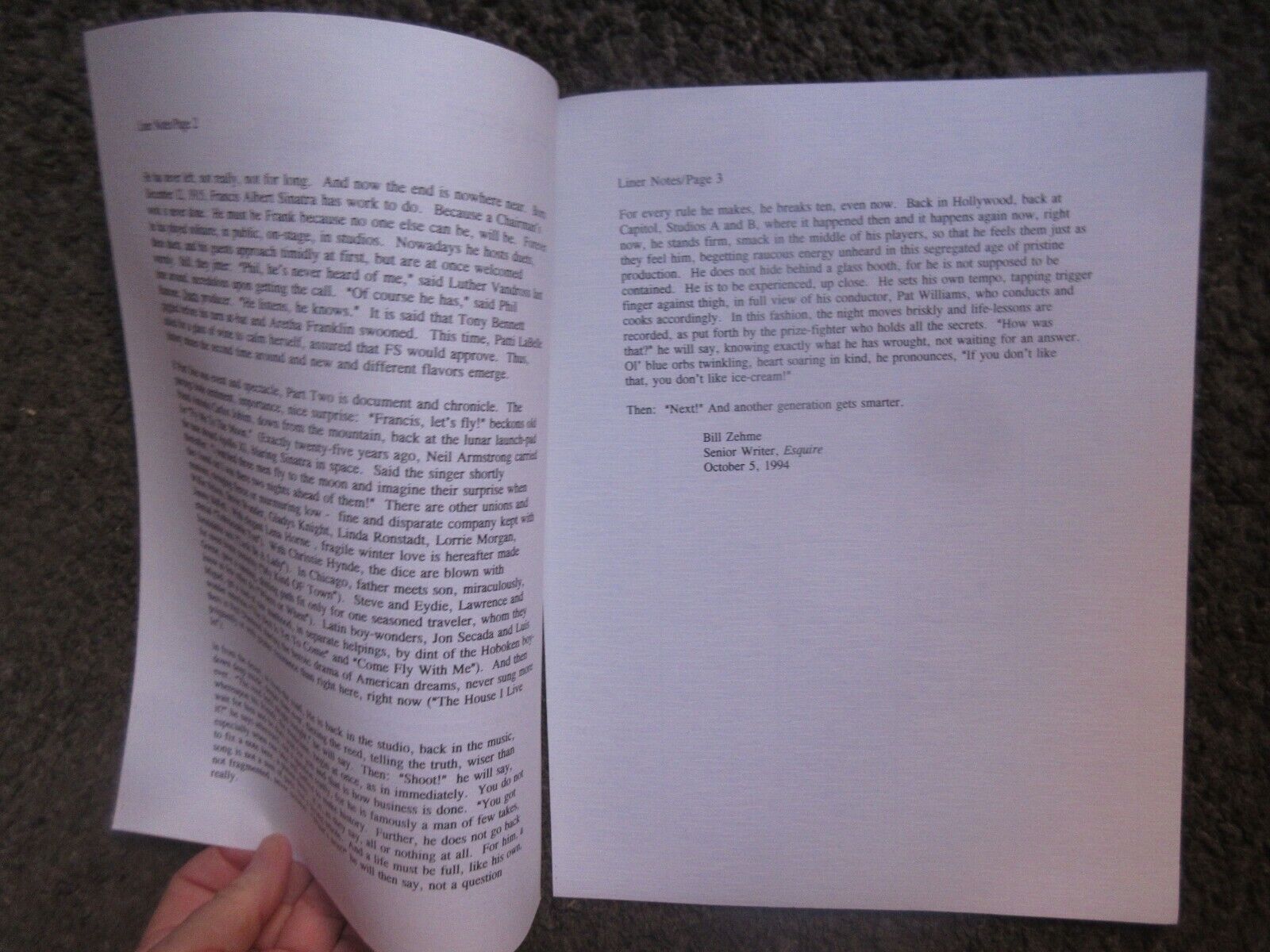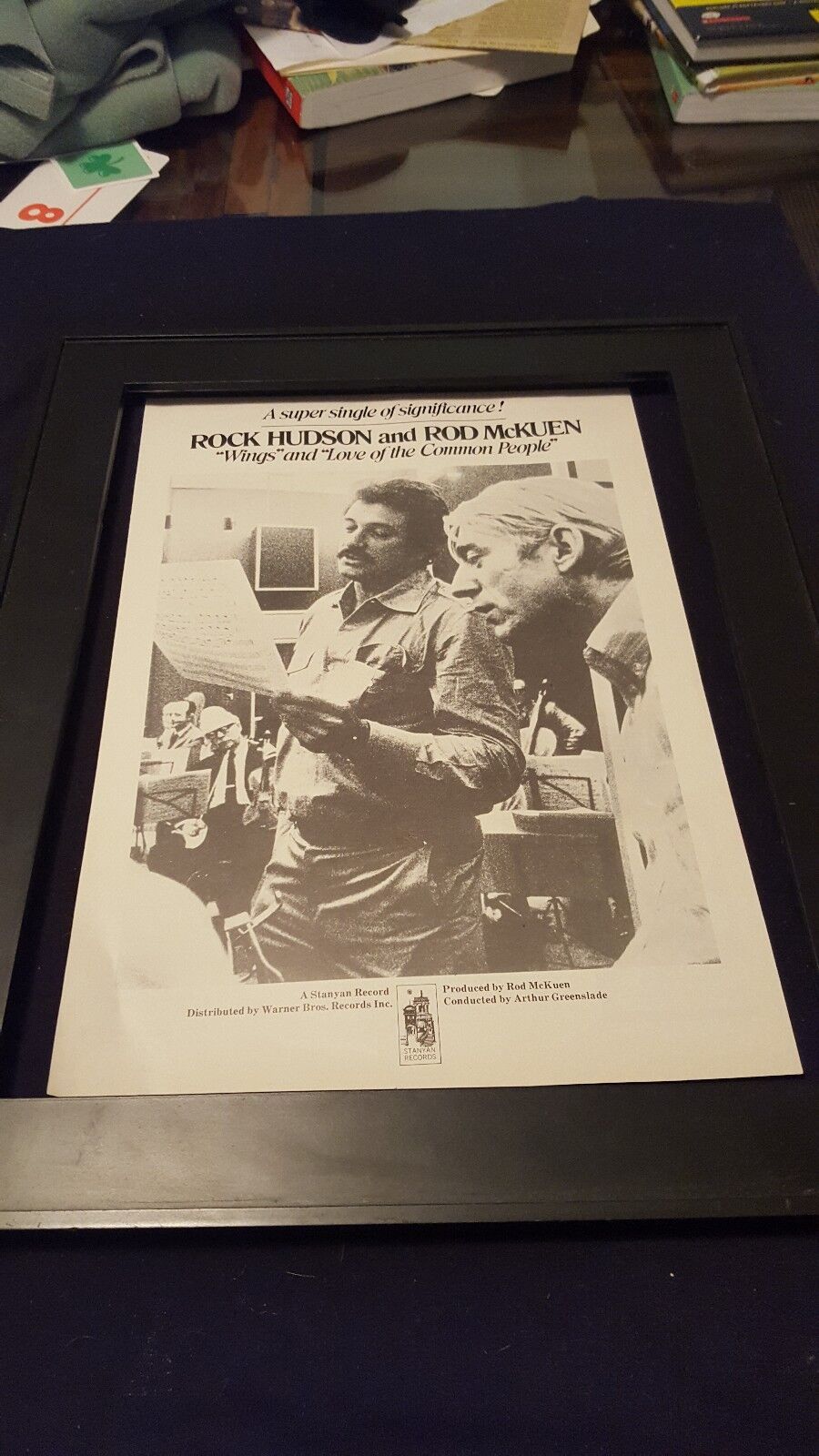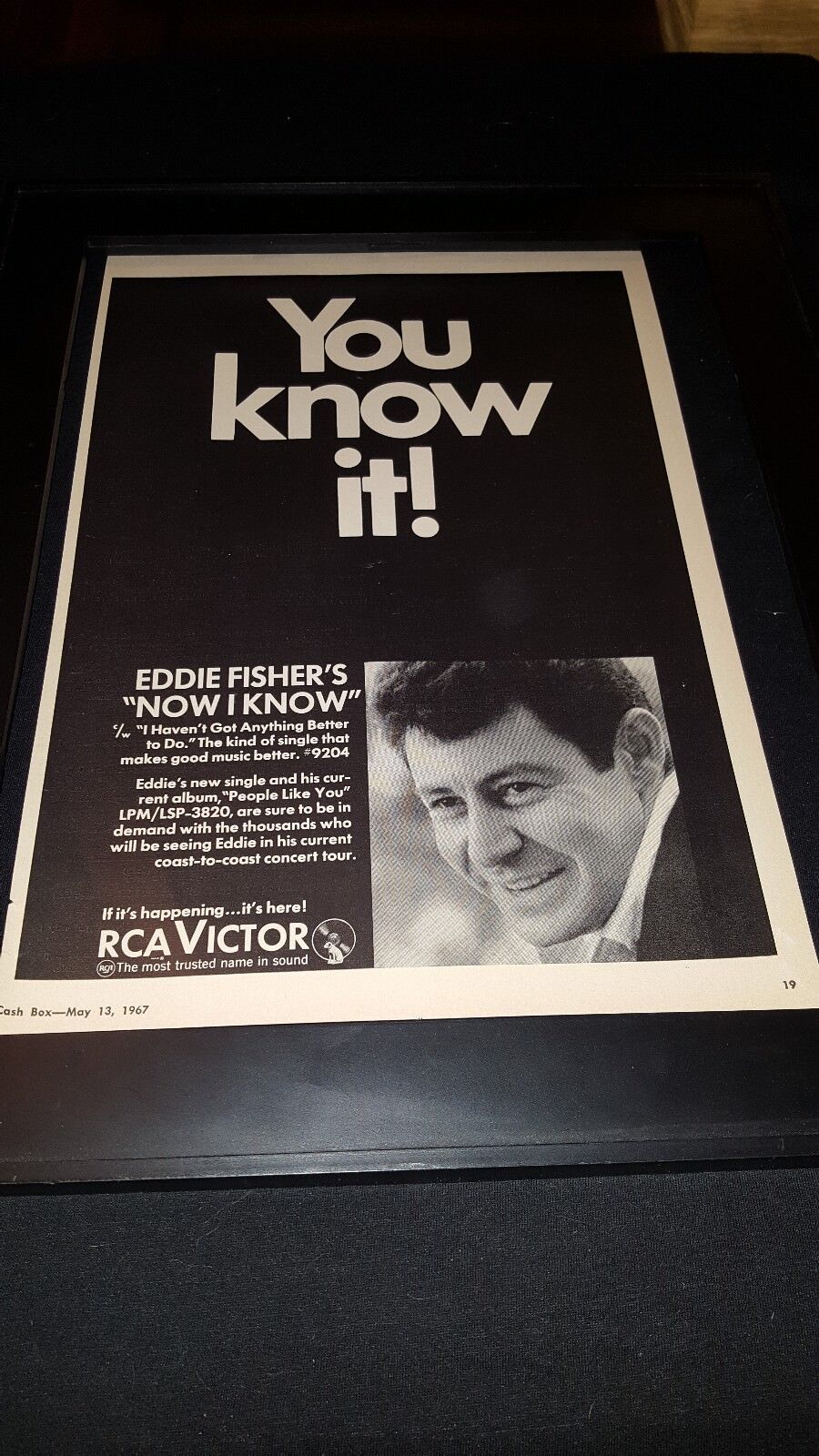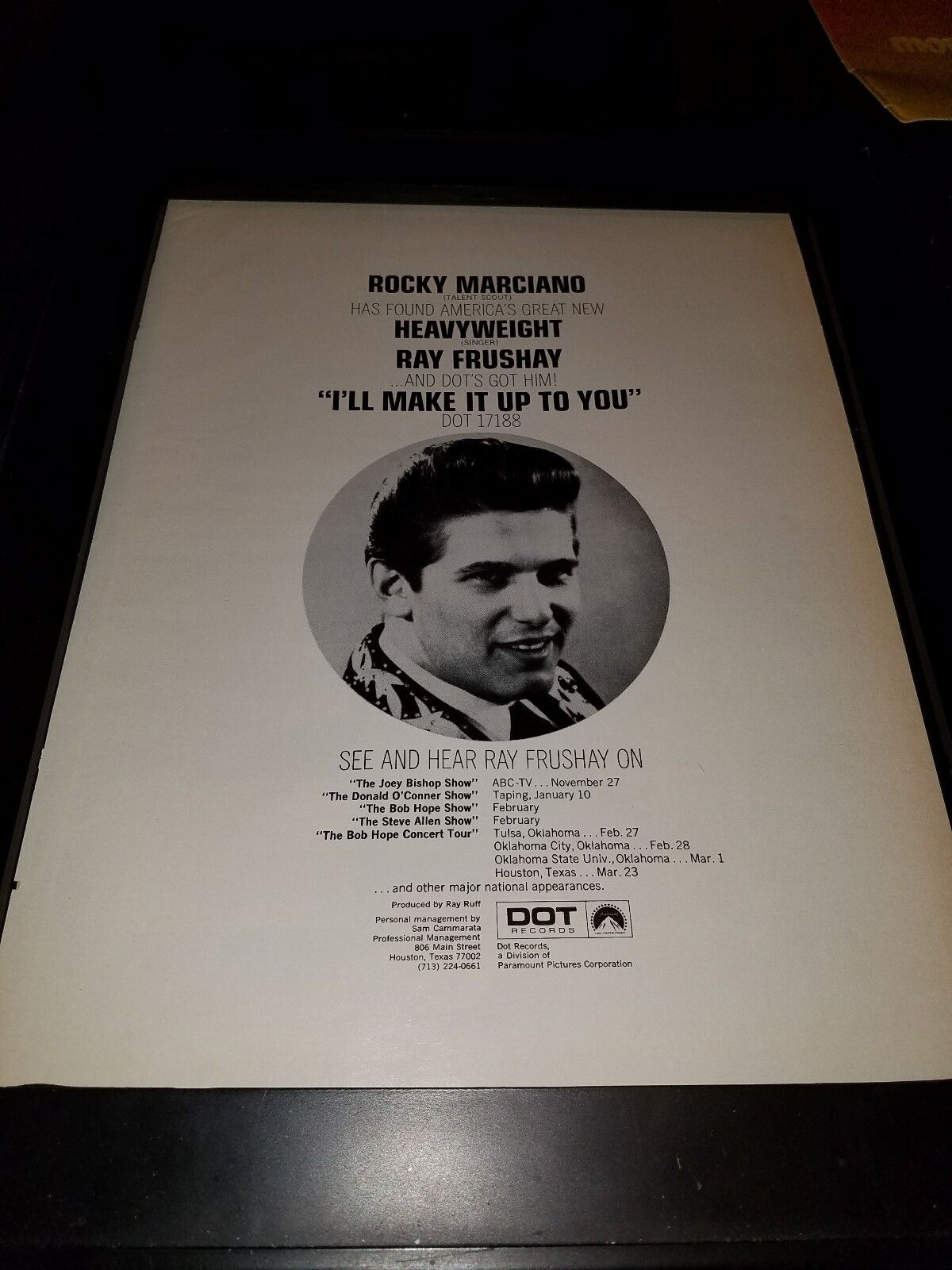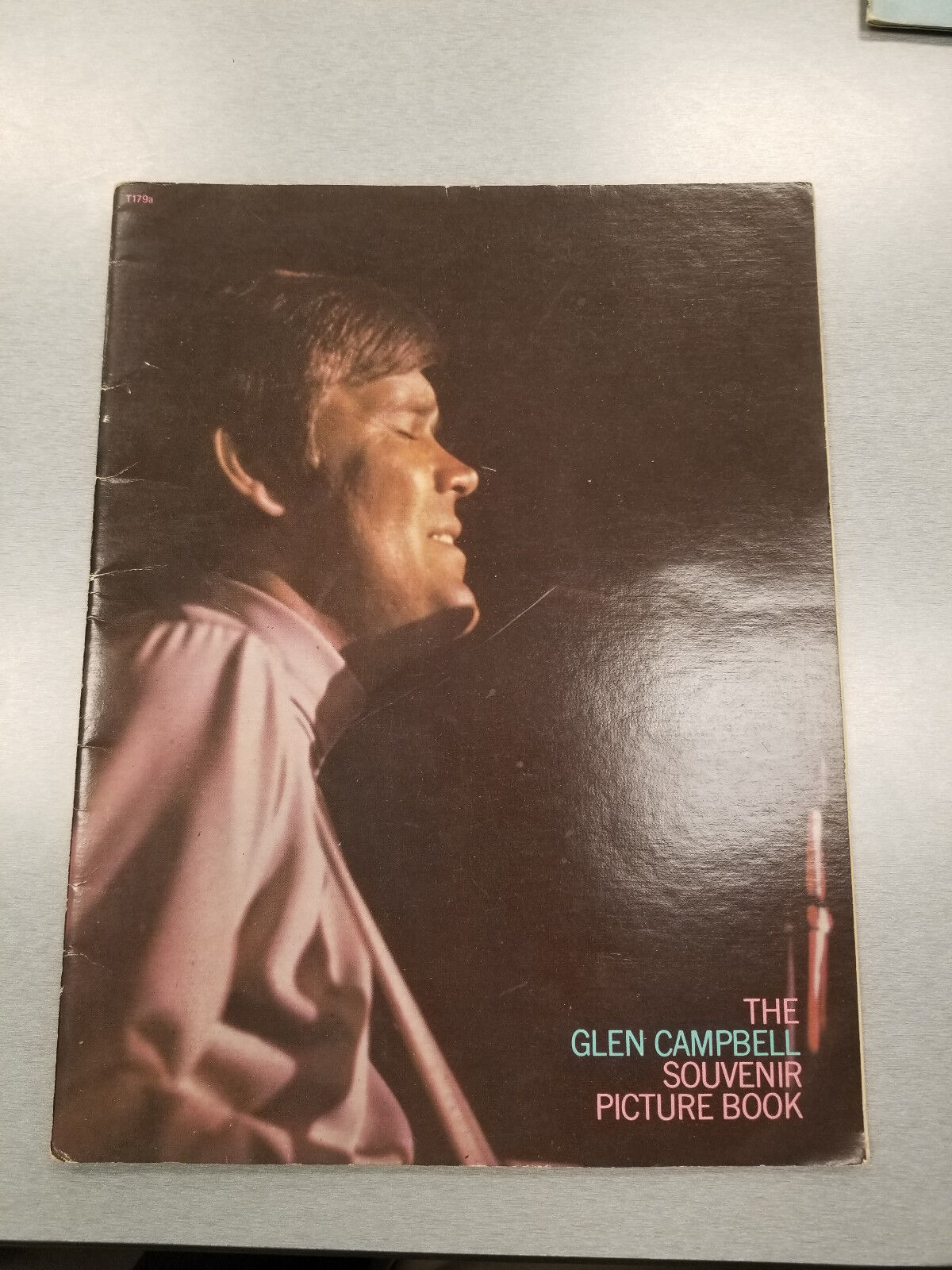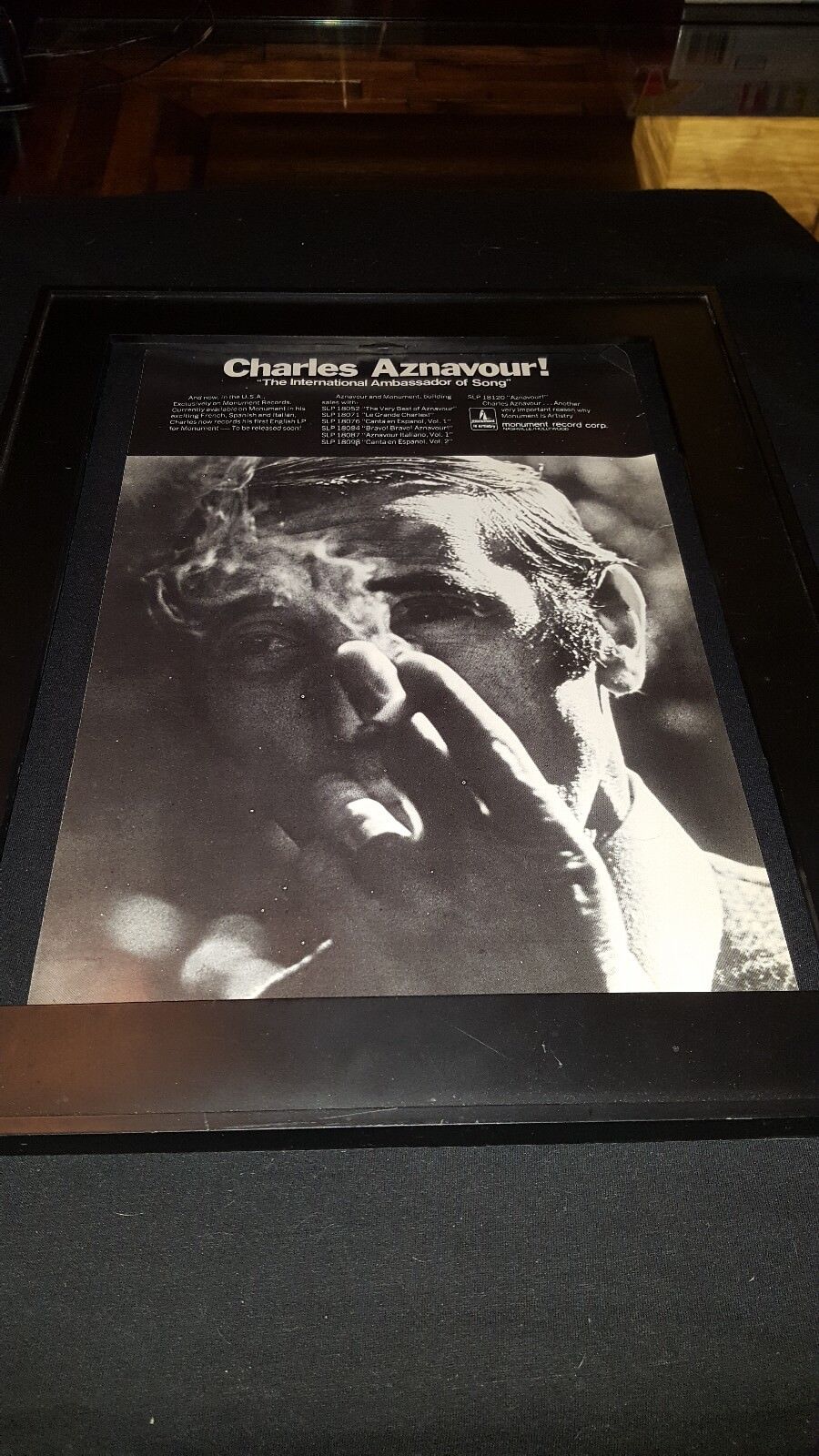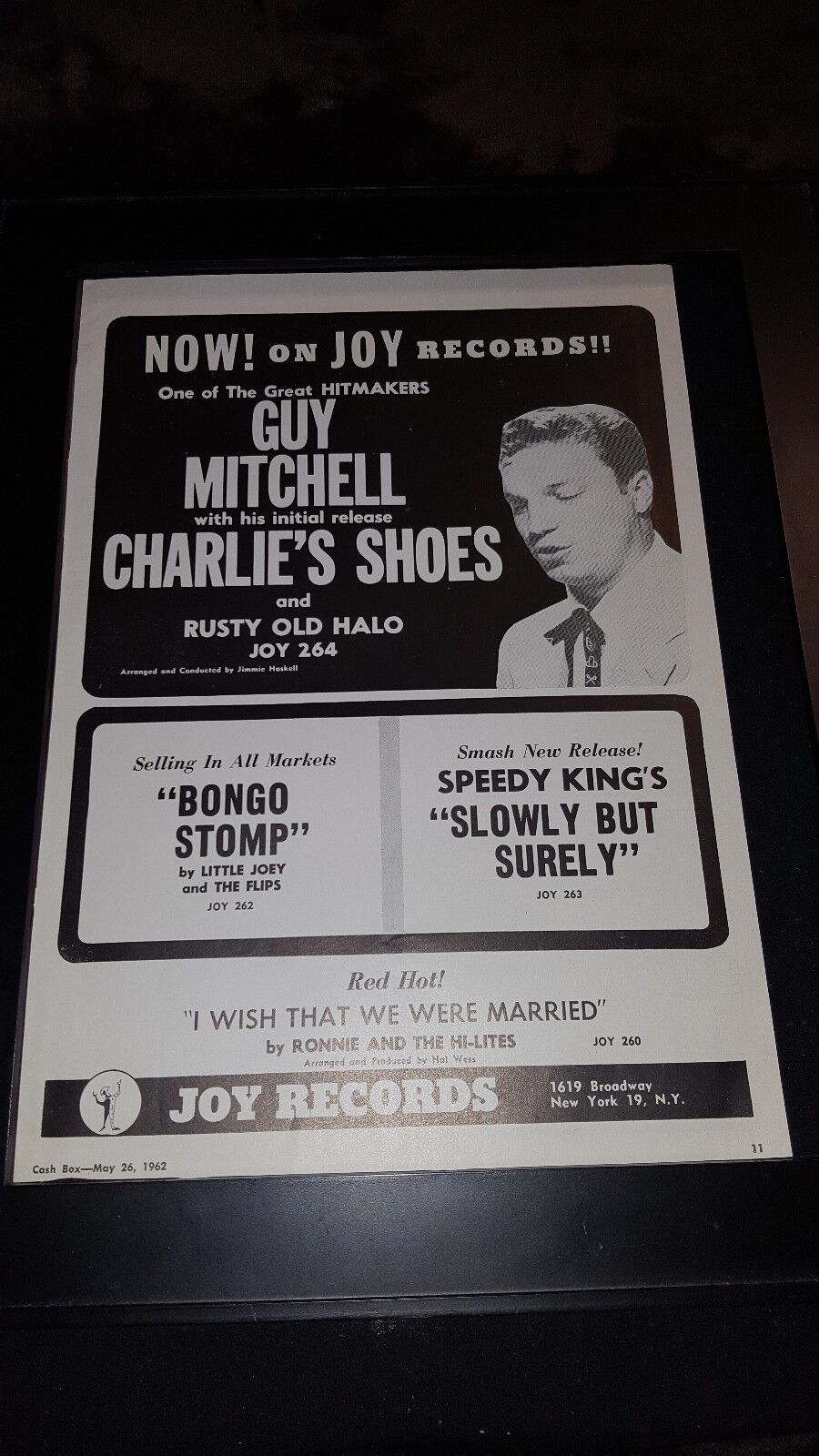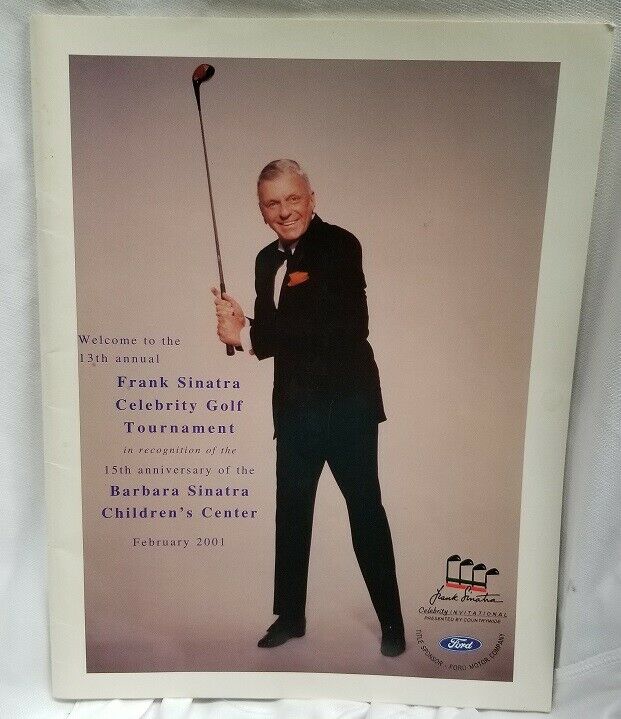-40%
FRANK SINATRA "DUETS II" 1994 CAPITOL RECORDS 16 PAGE PRESS KIT (NO PHOTO/FOLDER
$ 3.16
- Description
- Size Guide
Description
NOTE: DUE TO THE VIRUS INTERNATIONAL SHIPPING IS LIMITED, PLEASE CHECK THE SHIPPING TAB TO SEE IF I AM SHIPPING TO YOUR COUNTRY.THANKS!BEING THE MUSIC AND PROMOTION DIRECTOR FOR A NATIONAL RADIO NETWORK GOT ME ON MANY RECORD LABEL PRESS LISTS. I HAVE DECIDED TO CLEAR OUT SOME SPACE IN MY STORAGE UNIT, THIS PRESS KIT IS FROM MY TIME AT THE RADIO NETWORK.IT WILL MAIL OUT INSIDE A PROTECTIVE PLASTIC OUTER SLEEVE WITH CARDBOARD BACKING.
THE PICTURES ARE OF THE ACTUAL ITEM I AM SELLING, SORRY IF ANY OF THE PHOTO'S ARE BLURRY, OR A LIGHT GLARE, DUE TO THE LIGHTING IN MY APT. FEEL FREE TO ASK QUESTIONS. I HAVE A FEW FOR SALE. AND I DO COMBINE SHIPPING. THANKS FOR LOOKING! ....
ALSO NOTE: EBAY IS NOT ALLOWING COPY & PASTE INFO THAT INCLUDES HYPERLINKS, SO THERE MAY NOT BE ARTIST OR OTHER INFO BELOW, PLEASE LOOK ONLINE IF YOU NEED MORE INFO OR MESSAGE ME. THANKS IN ADVANCE! BOB. NOTE I DO NOT ACCEPT “BEST OFFERS”.
THIS IS PRETTY MUCH MOST OF THE 1994 CAPITOL RECORDS PRESS KIT FOR THE THEN UPCMOING FRANK SINTRA “DUETS II” ALBUM, I RECENTLY SOLD ONE THAT CAME IN THE ORIGINAL FOLDER AND HAD THE ALBUM ART PUBLICITY PHOTO, BUT THIS IS VERY NICE TOO, IT DOES COME IN A CAPITOL RECORDS EMBOSSED FRONT COVER PUBLICITY FOLDER, THERE IS WRITING IN THE UPPER RIGHT CORNER. THERE'S A THRRE PAGE “MEDIA INFORMATION” PRESS RELEASE WITH “LINER NOTES”,THEN THERE'S A FOUR PAGE BIO ON FRANK SINATRA ON CAPITOL LETTERHEAD AND ATTACHED TO THAT IS AONE SHEET WITH A DISCOGRAPHY OF HIS CAPITOL RECORDS RELEASES, THEN THERE'S A COOL THREE PAGE BIO OF THE OTHER ARTISTS THAT PERFORM ON THE ALBUM. AND A DOUBLE SIDED ONE SHEET WITH HISTORY OF CAPITOL RECORDS, THERE'S ALSO A DOUBLE SIDED ONE SHEET WITH THE “BEHIND THE SCENES” FOLKS INVOLVED IN THE PROJECT, ALL OF THESE ON CAPITOL LETTERHEAD, THEN THERE'S A DOUBLE SIDED RELEASE ON EMI RECORDS GROUP LETTERHEAD WITH A BIO ON THEN CEO CHARLES KOPPELMAN, SO EVEN THO I DON'T HAVE THE ORIGINAL PUBLICITY FOLDER OR PUBLICITY PHOTO IT'S A NICE ADDITION TO A FRANK SINATRA COLLECTION.
NOT SOLD TO THE GENERAL PUBLIC
MORE ON THE ARTIST/BAND:
Francis Albert Sinatra, 12 December 1915, Hoboken, New Jersey, USA, d. 15 May 1998, Los Angeles, California, USA. After working for a time in the office of a local newspaper, The Jersey Observer, Frank Sinatra decided to pursue a professional career as a singer. Already an admirer of Bing Crosby, he was impelled to pursue this course after attending a 1933 Crosby concert, and sang whenever and wherever he could, working locally in clubs and bars. Then, in 1935 he entered a popular US radio talent show, Major Bowes Amateur Hour. Also on the show was a singing trio, and the four young men found themselves teamed together by the no-nonsense promoter. The ad-hoc teaming worked, and the group, renamed ‘The Hoboken Four’, won first prize. Resulting from this came a succession of concert dates with the Major Bowes travelling show, along with club and occasional radio dates. By 1938 Sinatra was singing on several shows on each of a half-dozen radio stations, sometimes for expenses - often for nothing. The experience and, especially, the exposure were vital if he was to be recognized.
Among the bands with which he performed was one led by songwriter Harold Arlen but in 1939, shortly after he married his childhood sweetheart, Nancy Barbato, he was heard and hired by Harry James, who had only recently formed his own big band. James recognized Sinatra’s talent from the beginning and also identified the source of his determination to succeed, his massive self-confidence and powerful ego. During their brief association, James remarked to an interviewer, ‘His name is Sinatra, and he considers himself the greatest vocalist in the business. Get that! No one’s even heard of him! He’s never had a hit record, and he looks like a wet rag, but he says he’s the greatest.’ In 1939 and early 1940 Sinatra made a number of records with James and began to develop a small following. His records with James included ‘My Buddy’ and ‘All Or Nothing At All’.
In 1940 Sinatra was approached with an offer by Tommy Dorsey, then leading one of the most popular swing era bands. Only some six months had expired on Sinatra’s two-year contract with James, who must have realized he was parting with a potential goldmine, but he was a generous-spirited man and let the singer go. Sinatra had many successful records with Dorsey including ‘Polka Dots And Moonbeams’, ‘Imagination’, ‘Fools Rush In’, ‘I’ll Never Smile Again’, ‘The One I Love’, ‘Violets For Your Furs’, ‘How About You?’ and ‘In The Blue Of Evening’, some of which became fixtures in his repertoire. One record from this period became a major hit in 1941 when the USA entered World War II. This song, recorded at Sinatra’s second session with Dorsey in February 1940, was ‘I’ll Be Seeing You’, and its lyric gained a special significance for servicemen, and the women they had left behind. Sinatra’s popularity with the young female population, achieved despite, or perhaps because of, his gangling, unheroic and rather vulnerable appearance, prompted him to leave Dorsey and begin a solo career. In spite of the tough line taken by Dorsey over the remaining half of his five-year contract (Dorsey allegedly settled for 43% of the singer’s gross over the next 10 years), Sinatra quit.
Within months his decision proved to be right. He had become the idol of hordes of teenage girls, his public appearances were sell-outs and his records jostled with one another for hit status. In the early 40s he had appeared in a handful of films as Dorsey’s vocalist, but by the middle of the decade he began appearing in feature films as an actor-singer. These included lightweight if enjoyable fare such as Higher And Higher (1944), Anchors Aweigh (1945), It Happened In Brooklyn (1947), The Kissing Bandit (1948) and Double Dynamite (1951).
By the 50s, however, Sinatra’s career was in trouble; both as a singer and actor, he appeared to have reached the end of the road. His acting had suffered in part from the quality of material he was offered, and had accepted. Nevertheless, it was his film career that was the first to recover when he landed the role of Angelo Maggio in From Here To Eternity (1953) for which he won an Academy Award as Best Supporting Actor. Thereafter, he was taken seriously as an actor even if he was rarely given the same standard of role or achieved the same quality of performance. He continued to make films, usually in straight acting roles, but occasionally in musicals. Among the former were The Man With The Golden Arm (1955), one of the roles that matched his breakthrough performance as Maggio, Johnny Concho (1956), Kings Go Forth (1958), A Hole In The Head (1959), The Manchurian Candidate (1962), Von Ryan’s Express (1965), Assault On A Queen (1966), Tony Rome (1967) and The Detective (1968). His musicals included Guys And Dolls (1955), High Society (1956), Pal Joey (1957), The Joker Is Wild (1957), Can-Can (1960) and Robin And The 7 Hoods (1964). Later, he appeared in an above average television movie, Contract On Cherry Street (1977), and The First Deadly Sin (1980).
Soon after his Oscar-winning appearance in From Here To Eternity, Sinatra made a comeback as a recording artist. He had been recording for Columbia, where he fell out of step when changes were made to the company’s musical policy, and in 1953 he was signed by Capitol Records. The move to Capitol marked a change and produced a body of work that is by any standards, phenomenal. Between 1953 and 1961 the quality of his albums was remarkable. Sinatra’s first session at Capitol was arranged and conducted by Axel Stordahl whom Sinatra had known in the Dorsey band. For the next session, however, he was teamed with Nelson Riddle. Sinatra had heard the results of earlier recording sessions made by Nat ‘King’ Cole at Capitol on which Riddle had collaborated. Sinatra was deeply impressed by the results and some sources suggest that on joining Capitol he had asked for Riddle. The results of this partnership set Sinatra’s singing career firmly in the spotlight. Over the next few years classic albums such as Songs For Young Lovers, This Is Sinatra, A Swingin’ Affair, Come Fly With Me, Swing Easy!, In The Wee Small Hours and the exceptional Songs For Swingin’ Lovers set standards for popular singers that have rarely been equalled and almost never surpassed. The two men were intensely aware of one another’s talents and although critics were unanimous in their praise of Riddle, the arranger was unassumingly diffident, declaring that it was the singer’s ‘great talent that put him back on top’. For all Riddle’s modesty, there can be little doubt that the arranger encouraged Sinatra’s latent feeling for jazz, which helped to create the relaxed yet superbly swinging atmosphere that epitomized their work together. On his albums for Capitol, his own label Reprise Records, and other labels, sometimes with Riddle, other times with Robert Farnon, Neal Hefti, Gordon Jenkins, Quincy Jones, Billy May or Stordahl, Sinatra built upon his penchant for the best in American popular song, displaying a deep understanding of the wishes of composer and lyricist.
Fans old and new bought his albums in their tens of thousands and several reached the top in the Billboard charts. The 1955 album In The Wee Small Hours was in the charts for 29 weeks, reaching number 2; the following year’s Songs For Swingin’ Lovers charted for 66 weeks, also reaching the second spot. Come Fly With Me, from 1958, spent 71 weeks in the charts, reaching number 1, and other top positions were attained by 1958’s Only The Lonely (120 weeks), 1960’s Nice ‘N’ Easy (86 weeks), and in 1966, Strangers In The Night (73) weeks. The title song from this latter album also made number 1 in Billboard’s singles charts, as did the following year’s million-selling ‘Something Stupid’ on which he duetted with his daughter, Nancy Sinatra. At a time in popular music’s history when ballads were not the most appealing form, and singers were usually in groups and getting younger by the minute, these represented no mean achievements for a middle-aged solo singer making a comeback. The secret of this late success lay in Sinatra’s superior technical ability, his wealth of experience, his abiding love for the material with which he worked and the invariably high standards of professionalism he brought to his recordings and public performances.
During his stint with Dorsey, the singer had taken a marked professional interest in the band leader’s trombone playing. He consciously learned breath control, in particular circular breathing, and the use of dynamics from Dorsey. Additionally, he employed Dorsey’s legato style, which aided the smooth phrasing of his best ballad work. Complementing this, Sinatra’s enjoyment of jazz and the company of jazz musicians prompted him to adopt jazz phrasing, which greatly enhanced his rhythmic style. More than any other popular singer of his or previous generations, Sinatra learned the value of delayed phrasing and singing behind the beat, and he and his arrangers invariably found exactly the right tempo. His relaxed rhythmic style contrasted strikingly with the stiffer-sounding singers who preceded him. Even Crosby, whose popularity Sinatra eventually surpassed, later accommodated some of Sinatra’s stylistic devices. (Crosby’s habitual lazy-sounding style was of a different order from Sinatra’s and until late in his career he never fully shook off his 2/4 style, while Sinatra, almost from the start, was completely comfortable with the 4/4 beat of swing.)
Sinatra’s revived career brought him more attention even than in his heyday as the bobby-soxers’ idol. Much of the interest was intrusive and led to frequently acrimonious and sometimes violent clashes with reporters. With much of what is written about him stemming from a decidedly ambivalent view, the picture of the man behind the voice is often confused. Undoubtedly, his private persona is multi-faceted. He has been described by acquaintances as quick-tempered, pugnacious, sometimes vicious and capable of extreme verbal cruelty, and he has often displayed serious lack of judgement in the company he has kept. In marked contrast, others have categorically declared him to be enormously generous to friends in need and to individuals and organizations he believes can benefit from his personal or financial support. His political stance has changed dramatically over the years and here again his judgement seems to be flawed. At first a Democrat, he supported Roosevelt and later Kennedy with enormous enthusiasm. His ties with the Kennedy clan were close, and not always for the best of reasons. Sinatra was unceremoniously dropped by the Kennedys following allegations that he had introduced to John Kennedy a woman who became simultaneously the mistress of the President of the United States and a leading figure in the Mafia. Sinatra then became a Republican and lent his support as fund-raiser and campaigner to Richard Nixon and Ronald Reagan, apparently oblivious to their serious flaws.
An immensely rich man, with interests in industry, real estate, recording companies, and film and television production, Sinatra chose to continue working, making frequent comebacks and presenting a never-ending succession of ‘farewell’ concerts, which, as time passed, became less like concerts and more like major events in contemporary popular culture. He continued to attract adoring audiences and in the late 80s and early 90s, despite being in his mid- to late seventies, could command staggering fees for personal appearances. In 1992, a two-part television biography, Sinatra, was transmitted in the USA, produced by Tina Sinatra, and starring Philip Casnoff in the leading role. Almost inevitably, it topped the weekly ratings. In 1993 Capitol Records re-signed Sinatra after 30 years with Reprise Records and announced a new album as ‘the recording event of the decade’. Duets was a brilliant piece of marketing, although musically lacking: it had Sinatra teamed with a varied all-star cast, including Aretha Franklin, Carly Simon, Barbra Streisand, Tony Bennett, Natalie Cole, Kenny G. and U2’s Bono. A subsequent lesser volume, Duets II, featuring artists such as Stevie Wonder, Antonio Carlos Jobim, Chrissie Hynde, Willie Nelson, Lena Horne, Gladys Knight and Patti LaBelle, was released in 1994. Rumours of ill health persisted through 1996 and 1997, and although it was not confirmed, Alzheimer’s disease was cited as the most likely condition. The voice of the century was finally silenced on 15 May 1998. There were countless tributes from fans, world leaders and musicians.
When an assessment has to be made of his life, it is not the money or the worship of his fans that matters; neither is it the mixed quality of his film career and the uncertainties surrounding his personal characteristics and shortcomings. What really matters is that in his treatment of the classics from the Great American Songbook, Sinatra made a unique contribution to twentieth-century popular music. Despite an occasional lapse, when carefully crafted lyrics were replaced with his own inimitable (yet all too often badly imitated) phrases, over several decades he fashioned countless timeless performances. There are some songs that, however many singers may have recorded them before or since Sinatra, or will record them in the future, have become inextricably linked with his name: ‘I’ll Walk Alone’, ‘It Could Happen To You’, ‘I’ll Never Smile Again’, ‘Violets For Your Furs’, ‘How About You?’, ‘Jeepers Creepers’, ‘All Of Me’, ‘Taking A Chance On Love’, ‘Just One Of Those Things’, ‘My Funny Valentine’, ‘They Can’t Take That Away From Me’, ‘I Get A Kick Out Of You’, ‘You Make Me Feel So Young’, ‘Old Devil Moon’, ‘The Girl Next Door’, ‘My One And Only Love’, ‘Three Coins In The Fountain’, ‘Love And Marriage’, ‘Swingin’ Down The Lane’, ‘Come Fly With Me’, ‘Fly Me To The Moon’, ‘The Tender Trap’, ‘Chicago’, ‘New York, New York’, ‘Let Me Try Again’, ‘Night And Day’, ‘Here’s That Rainy Day’, ‘Strangers In The Night’, ‘I Thought About You’, ‘Lady Is A Tramp’, ‘Anything Goes’, ‘All The Way’, ‘One For My Baby’ and ‘I’ve Got You Under My Skin’.
Not all these songs are major examples of the songwriters’ art, yet even on lesser material, of which ‘My Way’ is a notable example, he provided a patina of quality the songs and their writers may not have deserved and that no one else could have supplied. Since the 70s Sinatra’s voice showed serious signs of decay. The pleasing baritone had given way to a worn and slightly rusting replica of what it once had been. Nevertheless, he sang on, adjusting to the changes in his voice and, as often as not, still creating exemplary performances of many of his favourite songs. In these twilight years he was especially effective in the easy-swinging mid-tempo he had always preferred and that concealed the inevitable vocal deterioration wrought by time.
In assessing Sinatra’s place in popular music it is very easy to slip into hyperbole. After all, through dedication to his craft and his indisputable love for the songs he sang, Sinatra became the greatest exponent of a form of music that he helped to turn into an art form. In so doing, he became an icon of popular culture, a huge achievement for a skinny kid from Hoboken. Writing in the Observer, when Sinatra’s retirement was thought, mistakenly, to be imminent, music critic Benny Green observed: ‘What few people, apart from musicians, have never seemed to grasp is that he is not simply the best popular singer of his generation... but the culminating point in an evolutionary process which has refined the art of interpreting words set to music. Nor is there even the remotest possibility that he will have a successor. Sinatra was the result of a fusing of a set of historical circumstances which can never be repeated.’ Sinatra himself never publicly spoke of his work in such glowing terms, choosing instead to describe himself simply as a ‘saloon singer’. Deep in his heart, however, Sinatra must have known that Green’s judgement was the more accurate and it is one that will long be echoed by countless millions of fans all around the world. Musically at least, it is a world better for the care that Frank Sinatra lavished upon its popular songs.
On his death the newspapers were ready to bring up his dark side, although fortunately the music, and his gigantic contribution to it, was acknowledged. He was no angel; many would testify to his arrogance, misogynistic and ruthless nature, but, Sinatra was the greatest interpreter of the popular song the world has ever known. As Gore Vidal remarked in 1998, it was likely that 50% of the current population of North America was conceived while Frank Sinatra was singing in the background. He was quite possibly right.
THIS WILL MAIL OUT WITH STURDY CARD BOARD BACKING INSIDE A PROTECTIVE PLASTIC OUTER SLEEVE.
I DO COMBINE SHIPPING IF ASKED.
ALL INTERNATIONAL SHIPPING IS BASED UPON WEIGHT AND COUNTRY. I WEIGH ITEMS+PACKING MATERIALS & PADDED MAILERS, BEFORE WRITING THAT INFO IN THE BOX THAT EBAY USES TO DETERMINE SHIPPING, I HAVE NO CONTROL OVER THAT.
IF YOU OPT TO NOT PAY FOR THE EXTRA INTERNATIONAL REGISTERED MAIL, AND OPT FOR THE REGULAR INTERNATIONAL FIRST CLASS WHICH HAS NO TRACKING AT ALL, I WILL NOT BE RESPONSIBLE FOR YOUR PACKAGE, AND I WILL TAKE PICTURES OF MY POST OFFICE RECEIPTS AND MY U.S. CUSTOMS FORMS AND SEND THEM TO YOU AS PROOF OF MY MAILING YOUR ITEM OUT, I AM NOT RESPONSIBLE FOR THE FAILINGS OF YOUR COUNTRIES POSTAL SERVICE, KNOW THIS BEFORE YOU BID ON ANY OF MY ITEMS!!! IF YOUR ITEM DOES NOT ARRIVE DO NOT BLAME ME!
DUE TO THE RECENT INCREASE IN THE INTERNATIONAL MAILING RATES THAT WENT UP ON JAN. 2020,. I WILL NOT DO A FLAT RATE FOR ANY ITEMS, FROM NOW ON YOU WILL HAVE TO CALCULATE THE RATE BASED UPON YOUR COUNTRY. ALSO ADDITIONAL COMBINED ITEMS WILL MEAN A HIGHER SHIPPING CHARGED BASED ON EACH ITEM. SORRY ABOUT THIS, BUT THERE’S NOTHING I CAN DO ABOUT THAT. REGISTERED INTERNATIONAL MAIL WHICH ALLOWS FOR DOOR TO DOOR TRACKING IS AN ADDITIONAL .00.
I DO COMBINE SHIPPING……….
CHECK OUT MY OTHER AUCTIONS
International Buyers – Please Note:
Import duties, taxes, and charges are not included in the item price or shipping cost. These charges are the buyer's responsibility.
Please check with your country's customs office to determine what these additional costs will be prior to bidding or buying.
PLEASE PAY FOR ALL ITEMS WITHIN 7 DAYS, OR MESSAGE ME TO EXPLAIN WHY YOU CAN’T,(IF YOU ARE BIDDING OR PLAN TO BID ON OTHER ITEMS) I WILL DO A ONE WEEK WAIT FROM THE DATE OF THE END OF THE FIRST AUCTION WIN, TO COMBINE SHIPPING ON ITEMS, AFTER THAT I NEED PAYMENT IN FULL AND WILL MAIL OUT THE ITEMS , EVEN IF YOU ARE BIDDING ON OTHERS, THUS BEGINS A NEW BILLING/SHIPPING CYCLE. THIS CASH FLOW IS MY SOURCE OF INCOME FOR PAYING RENT/BILLS, ETC. IF YOU HAVE WON AN ITEM AND I DO NOT HEAR FROM YOU ONE WAY OR THE OTHER WITHIN 7 DAYS I WILL OPEN AN “UNPAID ITEM CASE”, IN ORDER TO FREE UP THE ITEM FOR A POSSIBLE RE-LISTING OR A “SECOND CHANCE OFFER”. PLEASE WHEN YOU WIN AN ITEM TRY AND PAY FOR IT IN A TIMELY FASHION OR LET ME KNOW YOU ARE LOOKING AT OTHER ITEMS I HAVE LISTED, I MAIL ITEMS OUT WITHIN TWO WORKING DAYS ONCE PAYMENT IS RECEIVED. DO NOT ASK FOR ITEM TO ME MARKED “GIFT” ON CUSTOMS FORMS, INTERNATIONAL BUYERS ARE RESPONSIBLE FOR ALL DUTIES AND CUSTOMS FEE’S! CHECK WITH YOUR POST OFFICE, I WILL NOT PAY THEM.
NEW NOTE TO ALL POTENTIAL BIDDERS PLEASE! DO NOT BID IF YOU HAVE NO INTENTION OF PAYING FOR AN ITEM YOU MIGHT WIN, ALSO IF YOU ARE AN INTERNATIONAL BIDDER, PLEASE! BE AWARE OF THE COST OF INTERNATIONAL SHIPPING. I DO NOT LIKE OPENING UNPAID ITEM CASES BUT I WILL IF YOU NEGLECT TO PAY.
